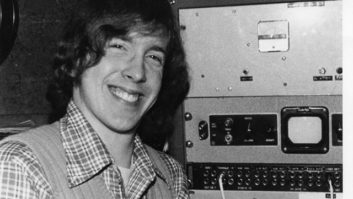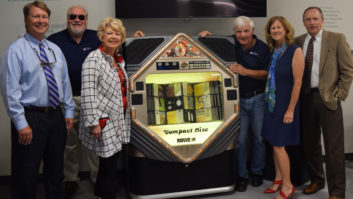Designed to work with an iPod, the four-channel Belkin TuneStudio portable mixer is aimed at aspiring rock musicians. But the multiple inputs and options of this versatile device — listed for $249.99 at www.belkin.com — open up real possibilities for budget-minded broadcasters.
The Belkin TuneStudio is about the size and shape of a mid-sized hardcover book opened up, lying on its pages so that the cover and spine are exposed. Imagine one side of the cover containing four channels of audio inputs, plus master dials for controlling the overall mix, and a mount for holding the iPod that serves as its recorder. The other cover has the input jacks.
(click thumbnail)The TuneStudio records the mix to a fifth-generation iPod or a second-generation iPod Nano. It outputs in uncompressed WAV files. The mixer’s four channels are organized vertically, using twist knobs. Each channel has a master level control, pan and controls for adjusting the low (80 Hz), medium (2.5 kHz) and high (12 kHz) frequency ranges of the input. Channels 1 and 2 also have gain adjusters for their XLR/1/4 inch inputs, ranging from +10/-10 to +60/+40. The TuneStudio also can provide 48 volts of phantom power either to XLR 1 or XLR 2.
On the right side of the board are controls for USB audio input, iPod audio playback, compression, Master Level, headphone and monitor levels and an audio-in-mix ratio to balance the input between the USB and iPod feeds. The TuneStudio also offers a three-position button that reduces the mix’s dB level by 3, 6 or 12 dB. Finally, the iPod mounting stand has a stereo 12-element (six per channel) recording level indicator, going from –24 dB to +6 dB.
On the back side are the TuneStudio’s inputs. Channels 1 and 2 each have one 1/4 inch (balanced or unbalanced) and one XLR (3-pin) female jack. Channel 3 has two 1/4 inch female jacks (balanced or unbalanced), and Channel 4 has a pair of unbalanced RCA female jacks (left and right). There also are a set of stereo (L/R) balanced/unbalanced 1/4 inch female jacks for outputting the mix, and a USB audio port.
“The TuneStudio records the mix to a fifth-generation iPod or a second-generation iPod Nano,” said Wannie Park, Belkin’s business unit manager of content creation and distribution.
(click thumbnail)Rendering of the TuneStudio front panel.“It outputs in uncompressed WAV files [akin to a CD], so the sound quality is pretty good.” The unit can be powered by batteries, or AC adaptor.
Broadcast potential
The TuneStudio is relatively new to the market. At this writing Belkin did not know of any broadcasters who had used the device.
Chris Hawkes, a performing musician and audio engineer producer, tested the TuneStudio in Austin, Texas.
“I’ve used everything from a full studio console on down, and the TuneStudio worked very well for me,” Hawkes said. “It had very lifelike audio reproduction, and I didn’t hear any discoloration or distortion during the recording process. My only complaint is that this mixer is not widely available yet.”
The TuneStudio’s ability to accept two XLR microphone inputs, plus two other channels of stereo audio, could make it highly useful for radio broadcasters.
In live mode, the TuneStudio could be used as an on-site mixer for remote broadcasters. If the DJs were given a laptop computer capable of playing audio tracks, they could theoretically produce an entire broadcast on location. It would be possible to achieve excellent sound quality at minimal cost if fed through a reasonably sized Internet pipe. The TuneStudio also could be used for off-site sports coverage, or news broadcasts from conventions and other such events.
In record mode, stations could use the TuneStudio to record live concerts economically in their communities, then play them back to air afterwards.
At a time when satellite radio and other forms of non-local competition are biting into the market, such features could give local stations an edge in holding onto existing listeners, and attracting new ones. Moreover, the audio also could be streamed on their Web sites.
The bottom line: For $249.99, the Belkin TuneStudio offers an economical solution to the challenges of outside broadcasting and recording for cash-conscious broadcasters.













